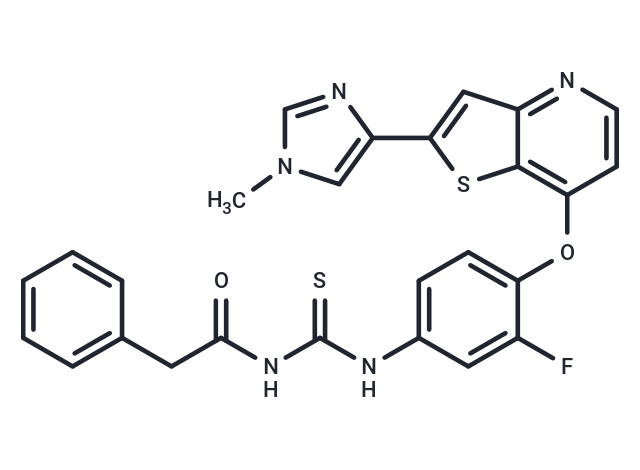Shopping Cart
- Remove All
 Your shopping cart is currently empty
Your shopping cart is currently empty

MGCD-265 analog (Glesatinib) is an orally bioavailable multitargeted tyrosine kinase inhibitor with potential antineoplastic activity with IC50 of 29 nM and 10 nM for c-Met and VEGFR2, respectively.

| Pack Size | Price | Availability | Quantity |
|---|---|---|---|
| 2 mg | $30 | In Stock | |
| 5 mg | $48 | In Stock | |
| 10 mg | $77 | In Stock | |
| 25 mg | $167 | In Stock | |
| 50 mg | $268 | In Stock | |
| 100 mg | Preferential | In Stock | |
| 1 mL x 10 mM (in DMSO) | $56 | In Stock |
| Description | MGCD-265 analog (Glesatinib) is an orally bioavailable multitargeted tyrosine kinase inhibitor with potential antineoplastic activity with IC50 of 29 nM and 10 nM for c-Met and VEGFR2, respectively. |
| Targets&IC50 | VEGFR2:10 nM, c-Met:29 nM |
| In vitro | MGCD-265 is a multi-target inhibitor of receptor tyrosine kinases. MGCD-265 potently inhibits Met, MetY1235D, MetM1250T, VEGFR1, VEGF2, VEGF3, Ron, and Tie2, with IC50 values ranging from 1 nM to 7 nM. [1] MGCD-265 inhibits cell proliferation both in c-Met-driven tumor cells (MKN45, MNNG-HOS, and SNU-5) and in non-c-Met-driven tumor cells (HCT116 and MDA-MB-231), with IC50 values of 6 nM–30 nM and 1 μM–3 μM, respectively. In serum starved MKN45 cells, MGCD-265 (40 nM–5 μM) effectively inhibits c-Met phosphorylation and its downstream signaling pathways, including Erk, Akt, Stat3, and Fak. MGCD-265 (6 nM–1 μM) also induces apoptosis in MKN45 cells. |
| In vivo | In c-Met-driven or non-c-Met-driven mice xenograft models of MKN45, U87 mg, MDA-MB-231, COLO205, and A549 tumor cells, MGCD-265 (20 mg/kg–60 mg/kg) inhibits tumor growth and c-Met signaling. MGCD-265 (40 mg/kg) also downregulates genes involved in angiogenesis, including VEGF and IL-8, both in tumor and plasma of mice with U87 mg xenograft. MGCD-265 also inhibits the plasma level of shed-Met. |
| Kinase Assay | Time-resolved fluorescence resonance energy transfer assay: The c-Met–catalyzed phosphorylation of N-biotinylated peptide (EQEDEPEGDYFEWLE-CONH2) is measured using a time-resolved fluorescence resonance energy transfer assay. [2] The MK-2461 IC50 for Ron, Mer, Flt1, Flt3, Flt4, KDR, PDGFRβ, FGFR1, FGFR2, FGFR3, TrkA, and TrkB are determined using time-resolved fluorescence resonance energy transfer assays similar to the c-Met kinase assay. |
| Cell Research | Cells are treated with MGCD-265 for 72 hours and cell number is determined as a function of mitochondrial activity, following incubation with MTT for 4 hours.(Only for Reference) |
| Molecular Weight | 517.6 |
| Formula | C26H20FN5O2S2 |
| Cas No. | 875337-44-3 |
| Smiles | Cn1cnc(c1)-c1cc2nccc(Oc3ccc(NC(=S)NC(=O)Cc4ccccc4)cc3F)c2s1 |
| Relative Density. | 1.41 g/cm3 |
| Storage | Powder: -20°C for 3 years | In solvent: -80°C for 1 year | Shipping with blue ice. | |||||||||||||||||||||||||||||||||||
| Solubility Information | Ethanol: < 1 mg/mL (insoluble or slightly soluble) H2O: < 1 mg/mL (insoluble or slightly soluble) DMSO: 96 mg/mL (185.47 mM), Sonication is recommended. | |||||||||||||||||||||||||||||||||||
Solution Preparation Table | ||||||||||||||||||||||||||||||||||||
DMSO
| ||||||||||||||||||||||||||||||||||||

Copyright © 2015-2025 TargetMol Chemicals Inc. All Rights Reserved.